Oldsmobile Cutlass Supreme 1993 s Repair Manual
Manufacturer: OLDSMOBILE, Model Year: 1993, Model line: Cutlass Supreme, Model: Oldsmobile Cutlass Supreme 1993Pages: 340, PDF Size: 16.21 MB
Page 61 of 340
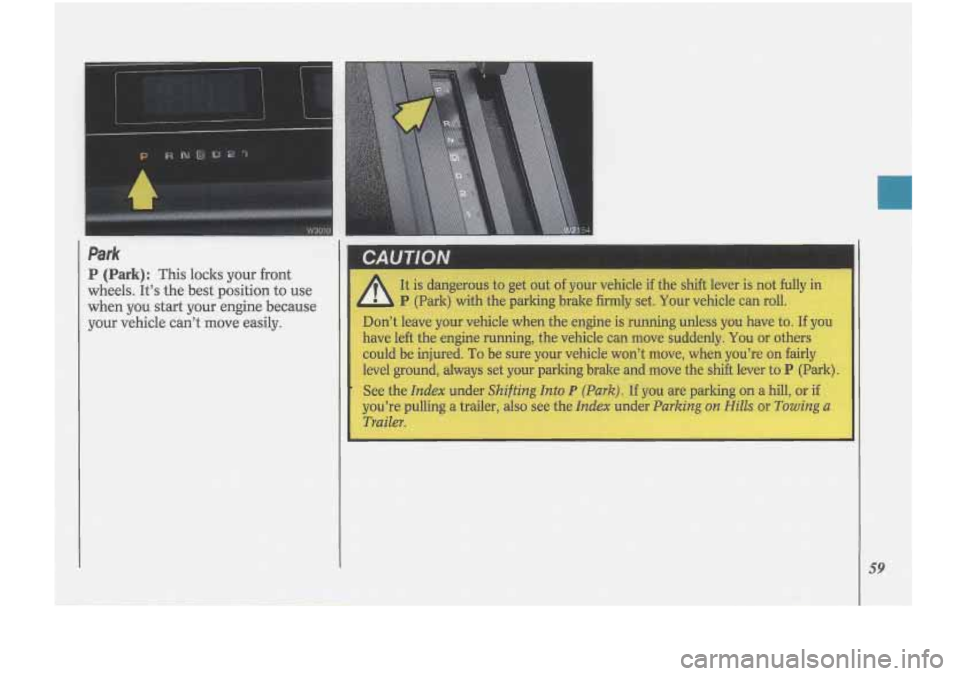
Park
P (Park): This loclcs your front
wheels. It’s the best position
to use
when you start your engine because
your vehicle can’t move easily.
A
I It is dangerous to get out of your vehicle if the shift lever is not fully in
P (Park) with the parking brake firmly set. Your vehicle can roll.
Don’t leave your vehicle when the engine
is running unless you have to. If you
have left the engine running, the vehicle can move suddenly. You or others
could be injured.
To be sure your vehicle won’t move, when you’re on fairly
level ground, always set your parking brake and move the shift lever to
P (Park).
See the
Index under Shifting Into P (Park). If you are parking on a hill, or if
you’re pulling a trailer, also see the
Index under Parking on Hills or Towing a I
Trailer. I
59
Page 62 of 340
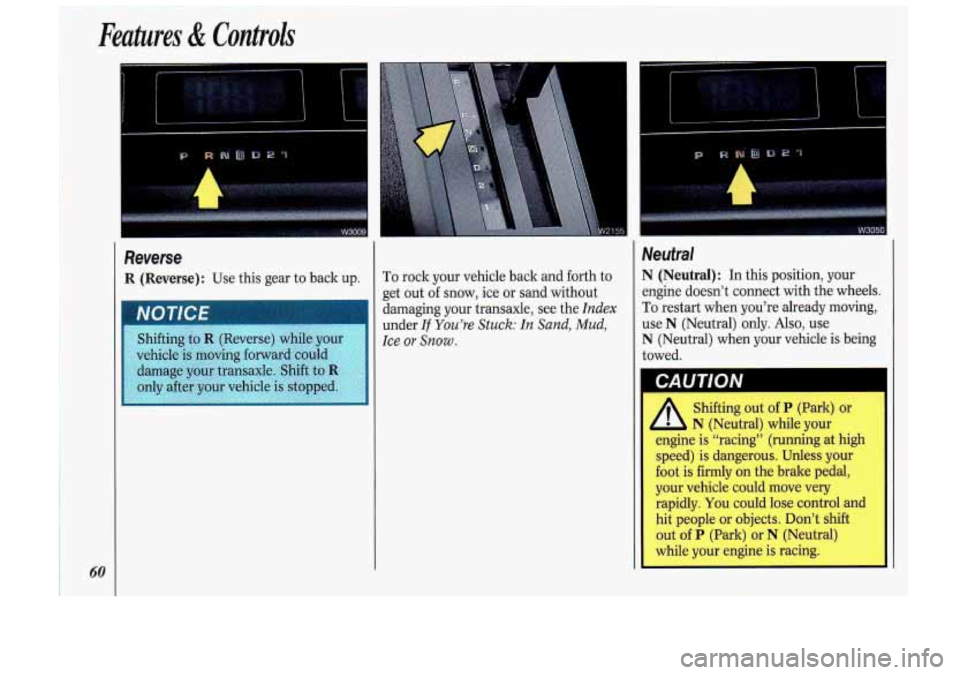
Features & Controls
1
Reverse
R (Reverse): Use this gear to back up. To rock your vehicle back and forth to
get out
of snow, ice or sand without
damaging your transaxle,
see the Index
under If You’re Stuck: In Sand, Mud,
Ice or Snow .
CY
Neutral
N (Neutral): In this position, your
engine doesn’t connect with the wheels.
To restart when you’re already moving,
use N (Neutral) only. Also, use
N (Neutral) when your vehicle is being
towed.
A
Shifting out of P (Park) or
N (Neutral) while your
engine is “racing” (running at high
speed) is dangerous. Unless your
foot is firmly on the brake pedal,
your vehicle could move very
rapidly.
You could lose control and
hit people
or objects. Don’t shift
out of
P (Park) or N (Neutral)
lwhile your engine
is racing.
Page 63 of 340
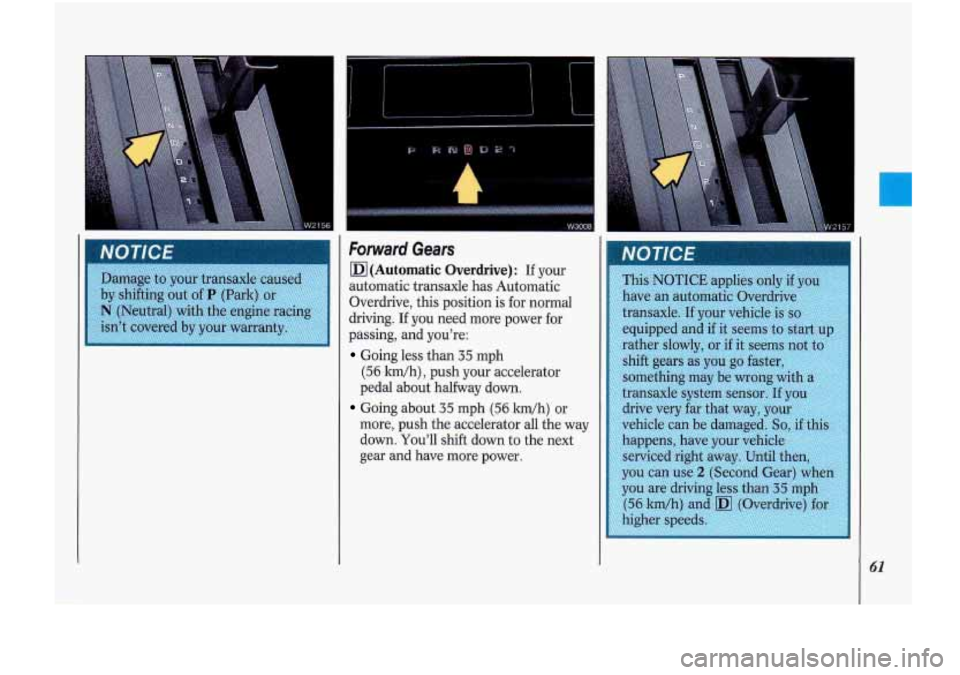
Forward Gears
(Automatic Overdrive): If your
automatic transaxle has Automatic Overdrive, this position is for normal
driving. If you need more power for
passing, and you’re:
Going less than 35 mph
(56 lun/h) , push your accelerator
pedal about halfway down.
Going about 35 mph (56 lun/h) or
more, push the accelerator all the way
down. You’ll
shift down to the next
gear and have more power.
1
61
Page 64 of 340
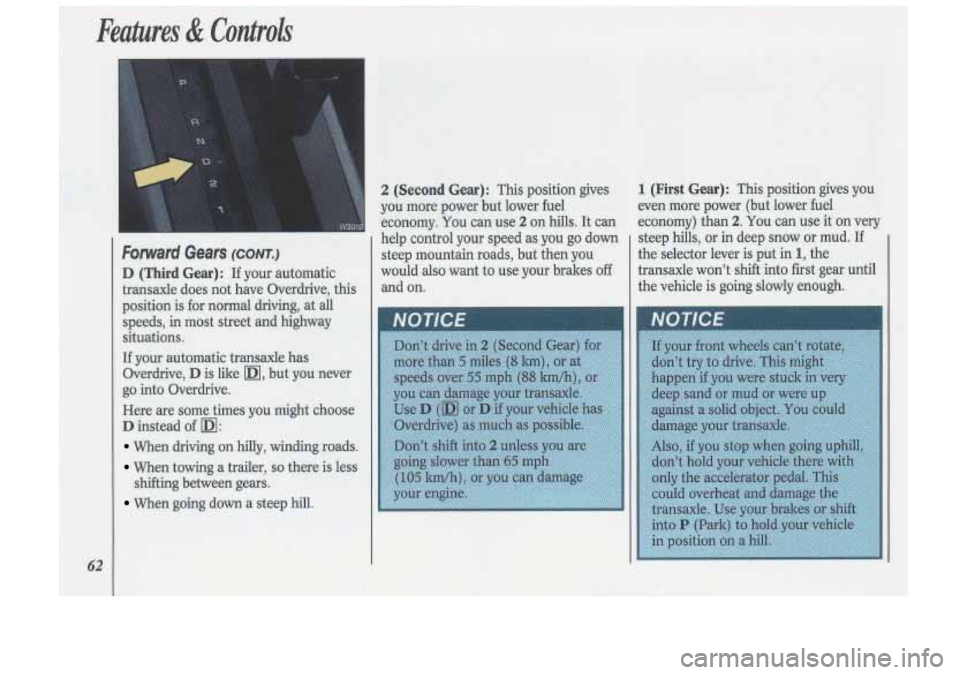
Features & ControIs
62
Forward Gears (CONT.)
D (Third Gear): If your automatic
transaxle does not have Overdrive, this
position is for normal driving, at all
speeds, in most street and highway
situations.
If your automatic transaxle has
Overdrive,
D is like m, but you never
go into Overdrive.
Here are some times you might choose
D instead of m:
When driving on hilly, winding roads.
When towing a trailer, so there is less
When going down a steep hill.
shifting between gears.
2 (Second Gear): This
position gives
you more power but lower fuel
economy.
You can use 2 on hills. It can
help control your speed as you go down
steep mountain roads, but then you
would also want to use your brakes
off
and on.
1 (First Gear): This position gives you
even more power (but lower fuel
economy) than
2. You can use it on very
steep hills, or in deep snow or mud.
If
the selector lever is put in 1, the
transaxle won’t shift into first gear until
the vehicle
is going slowly enough.
Page 65 of 340
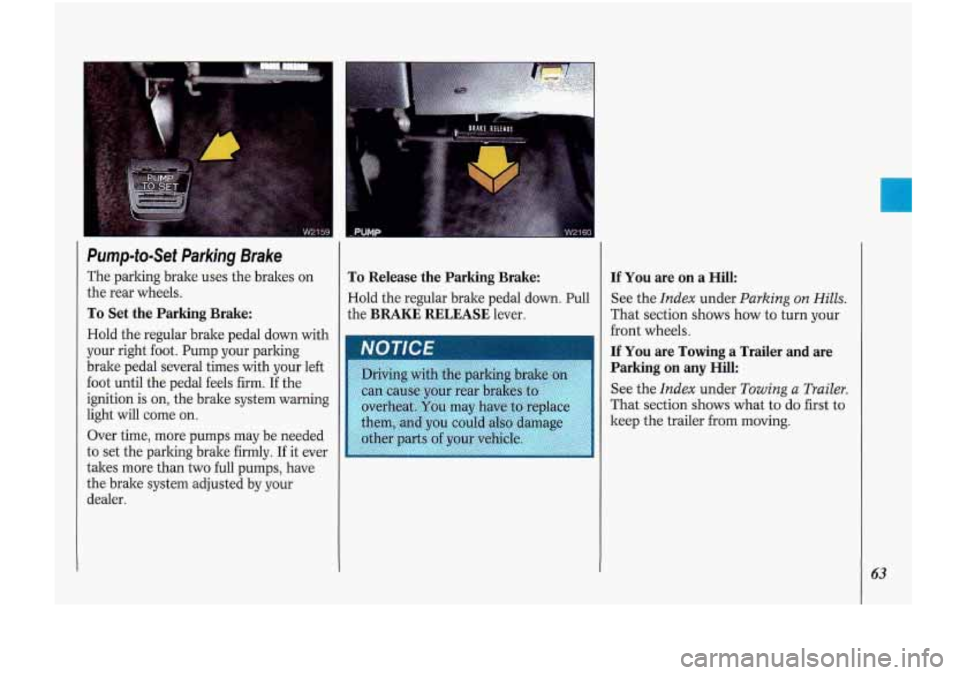
Pump-to-Set Parking Brake
The parking brake uses the brakes on
the rear wheels.
To Set the Parking Brake:
Hold the regular bralte pedal down with
your right foot. Pump your parking
brake pedal several times with your left
foot until the pedal feels firm. If the
ignition is
on, the brake system warning
light will come on.
Over time, more pumps may be needed
to set the parlung brake firmly. If it ever
takes more than two full pumps, have
the brake system adjusted by your
dealer.
..
To Release the Parking Brake:
Hold the regular brake pedal down. Pull
the
BRAKE RELEASE lever.
If You are on a Hill:
See the Index under Parking on Hills.
That section shows how to turn your
front wheels.
If You are Towing a Trailer and are
Parking on any Hill:
See the Index under Towing a Trailer.
That section shows what to do first to
keep the trailer from moving.
63
Page 66 of 340
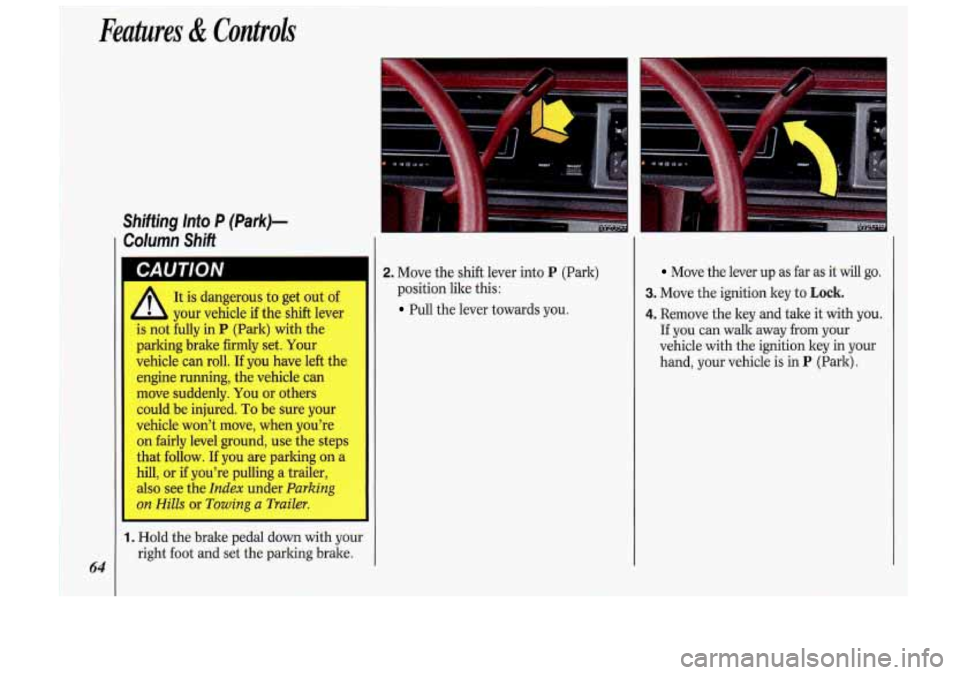
Features & Controli
64
Shifting lnto P (Park)-
Column Shift
It is dangerous to get out of
your vehicle if the shift lever
is not fully in
P (Park) with the
parking brake firmly set. Your
vehicle can roll. If you have left the
engine running, the vehicle can
move suddenly.
You or others
could be injured.
To be sure your
vehicle won't move, when you're
on fairly level ground, use the steps
that follow.
If you are parking on a
hill, or if you're pulling a trailer,
also see the
Index under Parking
on Hills or Towing a Trailer.
1. Hold the brake pedal down with your
right foot and set the parking brake.
'." ' I
2. Move the shift lever into P (Park)
position like this:
Pull the lever towards you.
Move the lever up as far as it will go.
3. Move the ignition key to Lock.
4. Remove the key and tale it with you.
If you can walk away from your
vehicle with the ignition key in your
hand, your vehicle
is in P (Park).
Page 67 of 340
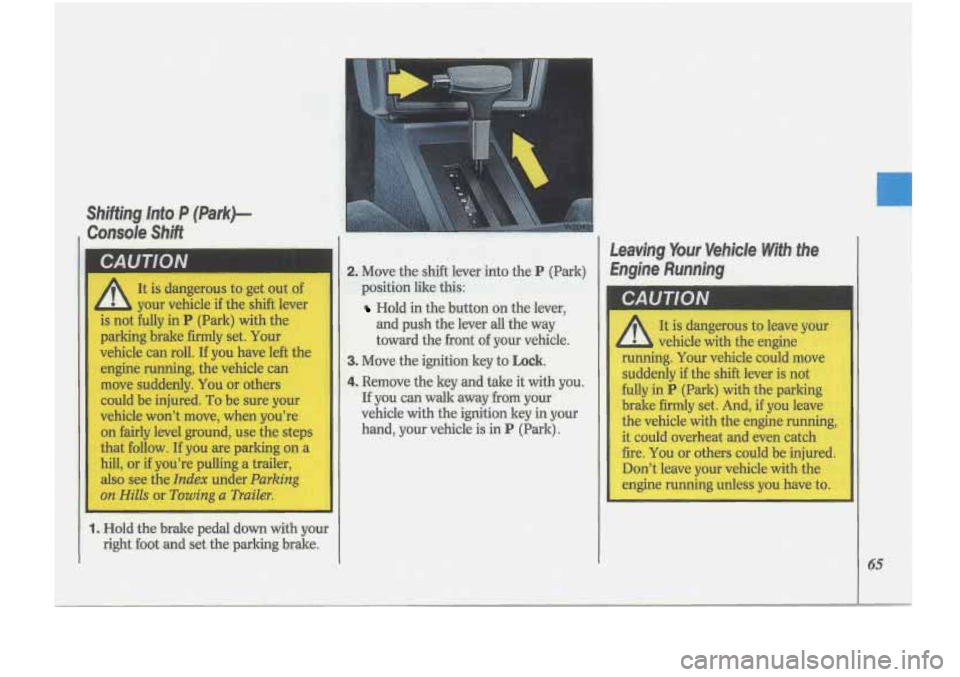
Shjfthg ‘Into P (Park)-
Console
Shift
A
It is dangerous to get out of
your vehicle
if the shift lever
is not fully
in P (Park) with the
parking brake firmly set. Your
vehicle can roll. If you have left the
engine running, the vehicle can
move suddenly. You or others
could be injured.
To be sure your
vehicle won’t move, when you’re
on fairly level ground, use the steps
that follow. If you are parking
on a
hill, or
if you’re pulling a trailer,
also see the
Index under Parking
on Hills or Towing a Trailer.
1. Hold the brake pedal down with your
right foot
and set the parking brake.
2. Move the shift lever into the P (Park)
position like this-:.
Hold in the button on the lever,
and push the lever
all the way
toward the front of your vehicle.
3. Move the ignition key to Lock.
4. Remove the key and take it with you.
If you can wallc away from your
vehicle with the ignition key
in your
hand, your vehicle is in
P (Park).
Leaving Yo,ur Vehicle Wfih the
Engine Running
I
Page 68 of 340
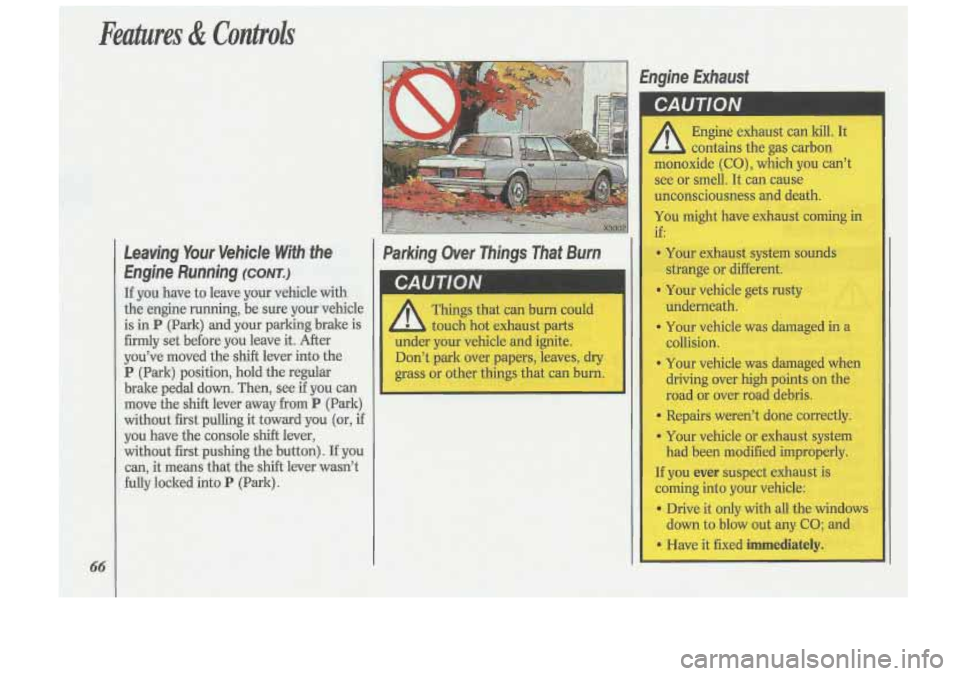
Parking Over Things That Burn
Things that can burn could
touch hot exhaust parts
under your vehicle and ignite.
Don’t park over papers, leaves,
dry
grass or other things that can burn.
Page 69 of 340
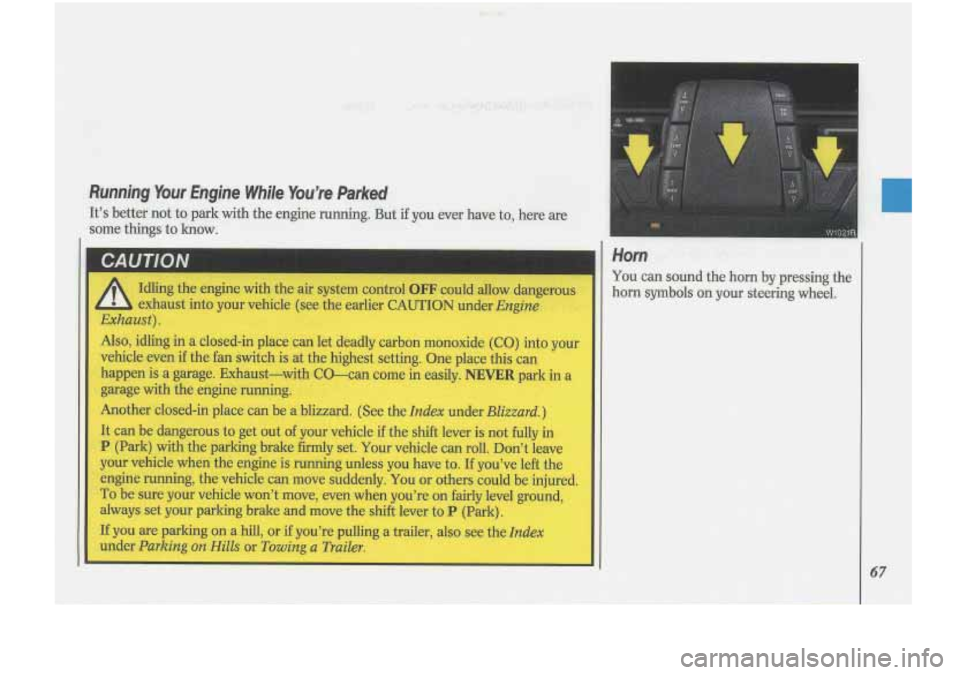
CAUTION --
A
Idling the engine with the air system control OFF could allow dangerous
exhaust into your vehicle (see the earlier CAUTION under
Engine
Zxhaust).
Also, idling in a closed-in place can let deadly carbon monoxide (GO) into your
vehicle even if the fan switch is at the highest setting. One place this can
happen is a garage. Exhaust-with CO-can come in easily.
NEVER park in a
garage with the engine running.
Another closed-in place can be a blizzard. (See the
Index under Blizzard.)
It can be dangerous to get out of your vehicle if the shift lever is not fully in
P (Park) with the parking brake firmly set. Your vehicle can roll. Don't leave
your vehicle when the engine is running unless you have to. If you've left the
engine running, the vehicle can move suddenly. You or others could be injured.
To be sure your vehicle won't move, even when you're on fairly level ground,
always set your parking brake and move the shift lever to
P (Park).
If you are parking on a hill, or if you're pulling
a trailer, also see the Index
under Parking on Hills or Towing a Trailer.
Page 70 of 340

~ Features di Controls
Tilt Steering Wheel (OPTION)
A
tilt steering wheel allows you to
adjust the steering wheel before you
drive.
You can also raise it to the highest level
to give your legs more room when you
exit and enter the vehicle.
To tilt the wheel, hold the steering
wheel and pull the lever. Move the
steering wheel to a comfortable level,
then release the lever to lock the wheel
in place.
Windows
On a vehicle with manual windows, use
the window crank to open and close
each window.
Power Windows (OPTION)
With power windows, switches on the
driver’s armrest control each of the
windows when the ignition is on. In
addition, each passenger door has a
control switch for its
own window.
The driver’s window switch has a
Power Auto
Down feature. This switch
is labeled
AUTO. The driver’s window
can be opened a small amount by
tapping the rear of the switch.
To stop the window while it is lowering,
press the front of the
AUTO switch,
then release. To raise the window, press
and hold the front of the
AUTO switch.